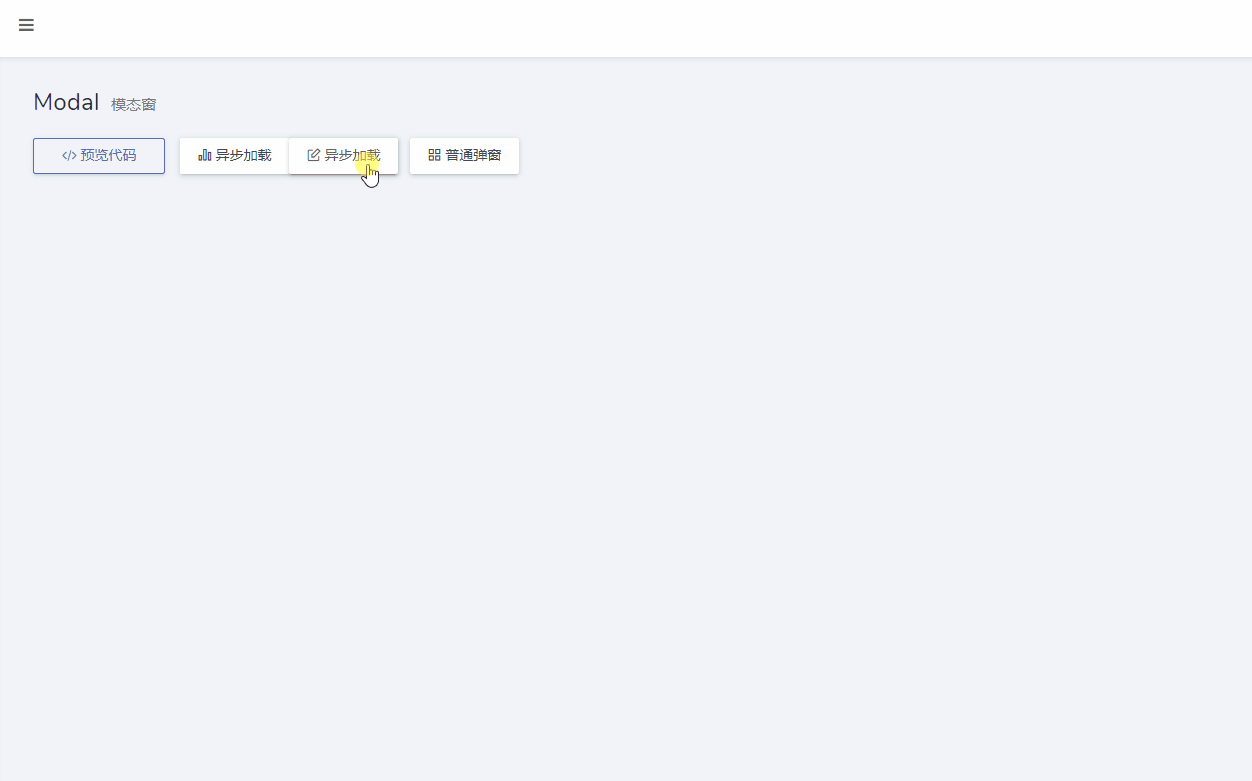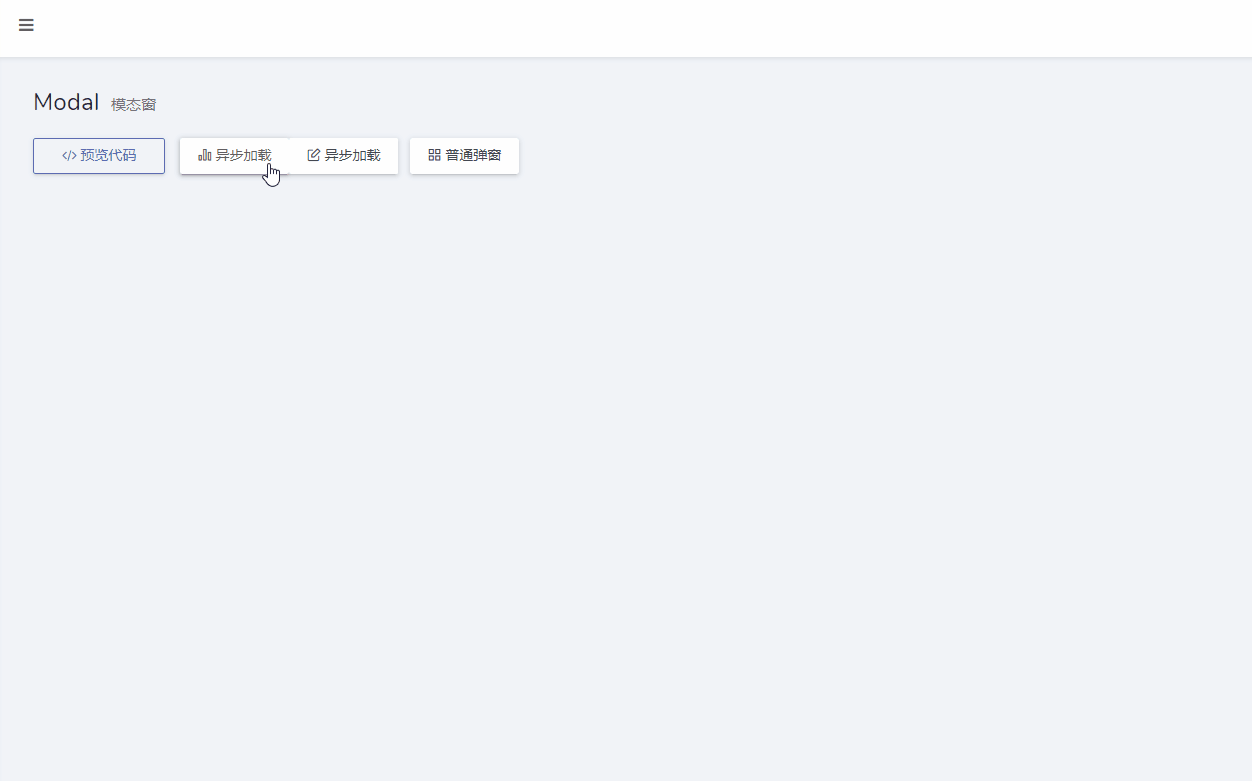Basic use of asynchronous loading
{tip} The asynchronous loading feature supports load on demand of static resources, and currently all built-in all components support the use of asynchronous rendering in anywhere on the page.
The asynchronous loading feature allows for asynchronous rendering of whole or partial components of a page using ajax to improve page load efficiency (e.g. popups to load forms asynchronously).
Basic Usage
The following is a simple example to demonstrate the use of the asynchronous load feature
First, define an asynchronous rendering class that inherits Dcat\Admin\Support\LazyRenderable
<?php
namespace App\Admin\Renderable;
use App\Admin\Widgets\Charts\Bar;
use Dcat\Admin\Support\LazyRenderable;
class PostChart extends LazyRenderable
{
public function render()
{
// Getting externally passed parameters
$id = $this->id;
// Query Data Logic
$data = [...];
// This can return built-in components, view files or HTML strings.
return Bar::make($data);
}
}Then you need to pass the rendering class instance into the Dcat\Admin\Widgets\Lazy object in order to achieve the final asynchronous rendering effect.
use App\Admin\Renderable\PostChart;
use Dcat\Admin\Widgets\Lazy;
use Dcat\Admin\Layout\Content;
public function index(Content $content)
{
// Instantiate asynchronous rendering classes and pass custom parameters
$chart = PostChart::make(['id' => ...]);
return $content->body(Lazy::make($chart));
}It can also be placed in the built-in components
{tip} In the case of components such as
Dcat\Admin\Widgets\Card,Dcat\Admin\Widgets\Box,Dcat\Admin\Widgets\Modal,Dcat\Admin\Widgets\Tab,Dcat\Admin\Widgets\Tabmay be omitted.Widgets\Lazycomponent, directly passing rendering class instances
use App\Admin\Renderable\PostChart;
use Dcat\Admin\Widgets\Card;
use Dcat\Admin\Layout\Content;
public function index(Content $content)
{
$chart = PostChart::make(['id' => ...]);
// The Card component supports passing LazyRenderable instances directly, bypassing the Lazy object.
return $content->body(Card::make($chart));
}
// In the case of Modal, Box, etc., you can just skip Lazy.
use Dcat\Admin\Widgets\Modal;
$chart = PostChart::make(['id' => ...]);
$modal = Modal::make()
->lg()
->title('TITLE')
->delay(300) // If the chart is rendered asynchronously, you need to set a delay time, otherwise the chart may render abnormally.
->body($chart);Of course, it can also be prevented in views or HTML code
use App\Admin\Renderable\PostChart;
use Dcat\Admin\Widgets\Lazy;
use Dcat\Admin\Layout\Content;
public function index(Content $content)
{
$chart = Lazy::make(PostChart::make(['id' => ...]));
return $content->body(view('admin.xxx', ['chart' => $chart]));
}result
Dcat\Admin\Support\LazyRenderable
parameter passing (payload)
use App\Admin\Renderable\PostChart;
PostChart::make(['key1' => '值', ...]);
// Can also be passed via the payload method
PostChart::make()->payload(['key1' => '值', ...]);Get Parameters
class PostChart extends LazyRenderable
{
protected $title = ['#', 'TITLE', '内容'];
public function render()
{
// Getting externally passed parameters
$key1 = $this->key1;
$key2 = $this->key2;
...
}
}Loading JS and CSS
The asynchronous load feature also supports static resources on demand and is very easy to use.
<?php
namespace App\Admin\Renderable;
use Dcat\Admin\Support\LazyRenderable;
use Dcat\Admin\Admin;
class CustomView extends LazyRenderable
{
// Write the paths to the js and css files that need to be loaded here
public static $js = [
'xxx/xxx1.js',
'xxx/xxx2.js',
];
public static $css = [
'xxx/xxx1.css',
'xxx/xxx2.css',
];
protected function addScript()
{
Admin::script(
<<<JS
console.log('The JS scripts are all loaded.~');
JS
);
}
public function render()
{
// Adding your JS code
$this->addScript();
return view('admin.custom', ['...']);
}
}Template file code examples, be careful not to include tags such as body and html etc.
<div id="custom" class="custom"><h2>asynchronous load function</h2></div>
<script>
Dcat.ready(function () {
// JS The code can also be placed in the template file
console.log('Template file execution js~');
});
</script>Dcat\Admin\Widgets\Lazy
onLoad
This method allows you to listen for asynchronous load completion events
use App\Admin\Renderable\PostChart;
use Dcat\Admin\Widgets\Lazy;
$chart = Lazy::make(PostChart::make())->onLoad(
<<<JS
console.log('Component rendering complete');
JS
);load
This method controls whether to render the asynchronous component immediately.
use App\Admin\Renderable\PostChart;
use Dcat\Admin\Widgets\Lazy;
use Dcat\Admin\Admin;
$lazy = Lazy::make(PostChart::make())->load(false);
Admin::script(
<<<JS
setTimeout(function () {
// Asynchronous rendering event triggered automatically after 3 seconds
{$lazy->getLoadScript()}
}, 3000);
JS
);JS events
use App\Admin\Renderable\PostChart;
use Dcat\Admin\Widgets\Lazy;
use Dcat\Admin\Admin;
$lazy = Lazy::make(PostChart::make());
Admin::script(
<<<JS
// Manually triggering asynchronous rendering events
$('{$lazy->getElementSelector()}').trigger('lazy:load');
// Listening for rendering completion events
$('{$lazy->getElementSelector()}').on('lazy:loaded', function () {
console.log('The component is rendered.')
});
JS
);Loading data tables asynchronously
If you need to load the data table asynchronously, you need to inherit Dcat\Admin\Grid\LazyRenderable when defining the rendering class
<?php
namespace App\Admin\Renderable;
use Dcat\Admin\Grid;
use Dcat\Admin\Grid\LazyRenderable;
use Dcat\Admin\Models\Administrator;
class UserTable extends LazyRenderable
{
public function grid(): Grid
{
return Grid::make(new Administrator(), function (Grid $grid) {
$grid->column('id');
$grid->column('username');
$grid->column('name');
$grid->column('created_at');
$grid->column('updated_at');
$grid->quickSearch(['id', 'username', 'name']);
$grid->paginate(10);
$grid->disableActions();
$grid->filter(function (Grid\Filter $filter) {
$filter->like('username')->width(4);
$filter->like('name')->width(4);
});
});
}
}Usage
use App\Admin\Renderable\UserTable;
use Dcat\Admin\Widgets\Modal;
use Dcat\Admin\Layout\Content;
public function index(Content $content)
{
$modal = Modal::make()
->lg()
->title('异步加载 - 表格')
->body(UserTable::make()) // Modal components support direct passing of rendering class instances.
->button('Open Form');
return $content->body($modal);
}result
Similarly, instances of the Render class can be attached to components such as Dcat\Admin\Widgets\Card, Dcat\Admin\Widgets\Box, Dcat\Admin\Widgets\Tab.
use App\Admin\Renderable\UserTable;
use Dcat\Admin\Widgets\Card;
$table = UserTable::make();
$card = Card::make('TITLE', $table)->withHeaderBorder();When the above code renders the UserTable instance, it is actually an instance of the Dcat\Admin\Widgets\LazyTable class automatically added at the bottom level.
use App\Admin\Renderable\UserTable;
use Dcat\Admin\Widgets\Card;
use Dcat\Admin\Widgets\LazyTable;
$table = LazyTable::make(UserTable::make()->simple());
$card = Card::make('TITLE', $table)->withHeaderBorder();Dcat\Admin\Grid\LazyRenderable
Dcat\AdminGrid\LazyRenderable is used for asynchronous rendering of data tables and is a subclass of Dcat\AdminSupport\LazyRenderable
Simplified model
This feature removes the ability to simplify some data forms that are enabled by default and not enabled by default.
use App\Admin\Renderable\UserTable;
use Dcat\Admin\Widgets\LazyTable;
use Dcat\Admin\Layout\Content;
public function index(Content $content)
{
$table = UserTable::make()->simple();
return $content->body(LazyTable::make($table));
}Note that if a rendering class instance is injected directly into a component such as Dcat\Admin\Widgets\Card, Dcat\Admin\Widgets\Box, Dcat\Admin\WidgetsTab and Dcat\Admin\WidgetsModal, Dcat\Admin\Widgets simple mode is automatically enabled.
use App\Admin\Renderable\UserTable;
use Dcat\Admin\Widgets\Card;
// simple mode is automatically enabled here.
$card = Card::make('TITLE', UserTable::make())->withHeaderBorder();If you don't want simple mode enabled, you can pass the LazyTable instance
use App\Admin\Renderable\UserTable;
use Dcat\Admin\Widgets\Card;
use Dcat\Admin\Widgets\LazyTable;
$table = LazyTable::make(UserTable::make());
$card = Card::make('TITLE', $table)->withHeaderBorder();Dcat\Admin\Widgets\LazyTable
onLoad
This method allows you to listen for asynchronous load completion events.
use App\Admin\Renderable\PostChart;
use Dcat\Admin\Widgets\Lazy;
$chart = Lazy::make(PostChart::make())->onLoad(
<<<JS
console.log('Component rendering complete');
JS
);load
This method controls whether to render the asynchronous component immediately. The default value is true.
use App\Admin\Renderable\UserTable;
use Dcat\Admin\Widgets\LazyTable;
use Dcat\Admin\Admin;
$lazy = LazyTable::make(UserTable::make())->load(false);
Admin::script(
<<<JS
setTimeout(function () {
// Asynchronous rendering event triggered automatically after 3 seconds
{$lazy->getLoadScript()}
}, 3000);
JS
);JS events
use App\Admin\Renderable\UserTable;
use Dcat\Admin\Widgets\LazyTable;
use Dcat\Admin\Admin;
$lazy = LazyTable::make(UserTable::make());
Admin::script(
<<<JS
// Manually triggering asynchronous rendering events
$('{$lazy->getElementSelector()}').trigger('table:load');
// Listening for rendering completion events
$('{$lazy->getElementSelector()}').on('table:loaded', function () {
console.log('The component is rendered.')
});
JS
);Asynchronous Loading Tool Form
Define the tool form class, implement the Dcat\Admin\Contracts\LazyRenderable, and load the trait of Dcat\Admin\Traits\LazyWidget.
<?php
namespace App\Admin\Forms;
use Dcat\Admin\Contracts\LazyRenderable;
use Dcat\Admin\Traits\LazyWidget;
use Dcat\Admin\Widgets\Form;
class UserProfile extends Form implements LazyRenderable
{
use LazyWidget;
public function handle(array $input)
{
return $this->response()->success('Save successfully');
}
public function form()
{
$this->text('name', trans('admin.name'))->required()->help('User nickname');
$this->image('avatar', trans('admin.avatar'))->autoUpload();
$this->password('old_password', trans('admin.old_password'));
$this->password('password', trans('admin.password'))
->minLength(5)
->maxLength(20)
->customFormat(function ($v) {
if ($v == $this->password) {
return;
}
return $v;
})
->help('Please enter 5-20 characters');
$this->password('password_confirmation', trans('admin.password_confirmation'))
->same('password')
->help('Please enter your confirmation password.');
}
}use
use App\Admin\Forms\UserProfile;
use Dcat\Admin\Widgets\Modal;
use Dcat\Admin\Layout\Content;
public function index(Content $content)
{
$modal = Modal::make()
->lg()
->title('Asynchronous Loading - Forms')
->body(UserProfile::make()) // Modal components support direct passing of rendering class instances
->button('Open Form');
return $content->body($modal);
}result

Asynchronous form instances, of course, can be used in other components as well
use App\Admin\Forms\UserProfile;
use Dcat\Admin\Widgets\Lazy;
use Dcat\Admin\Widgets\Card;
$form = UserProfile::make();
// Passing directly to Card Components
$card = Card::make($form);
// equal to
$card = Card::make(Lazy::make($form));Passing custom parameters
Passing parameters to an asynchronous form is very simple, modify the above form class as follows
<?php
namespace App\Admin\Forms;
use Dcat\Admin\Contracts\LazyRenderable;
use Dcat\Admin\Traits\LazyWidget;
use Dcat\Admin\Widgets\Form;
class UserProfile extends Form implements LazyRenderable
{
use LazyWidget;
public function handle(array $input)
{
// Getting externally passed parameters
$key1 = $this->payload['key1'] ?? null;
$key2 = $this->payload['key1'] ?? null;
return $this->response()->success('Save successfully');
}
public function form()
{
// Getting externally passed parameters
$key1 = $this->payload['key1'] ?? null;
$key2 = $this->payload['key1'] ?? null;
$this->text('name', trans('admin.name'))->required()->help('User nickname');
$this->image('avatar', trans('admin.avatar'))->autoUpload();
$this->password('old_password', trans('admin.old_password'));
$this->password('password', trans('admin.password'))
->minLength(5)
->maxLength(20)
->customFormat(function ($v) {
if ($v == $this->password) {
return;
}
return $v;
})
->help('Please enter 5-20 characters');
$this->password('password_confirmation', trans('admin.password_confirmation'))
->same('password')
->help('Please enter your confirmation password.');
}
public function default()
{
// Getting externally passed parameters
$key1 = $this->payload['key1'] ?? null;
$key2 = $this->payload['key1'] ?? null;
return [
'name' => '...',
];
}
}Passing parameter code as follows
// Passing custom parameters
$form = UserProfile::make()->payload(['key1' => '...', 'key2' => '...']);
$modal = Modal::make()
->lg()
->title('Asynchronous Loading - Forms')
->body($form)
->button('Open Form');
